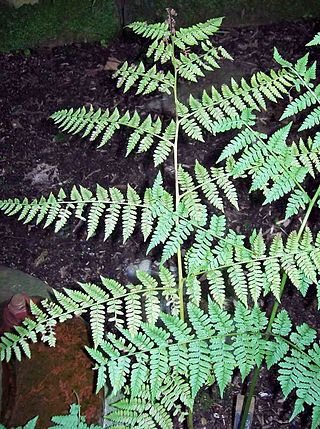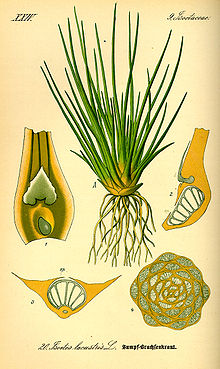
Isoetes, commonly known as the quillworts, is a genus of lycopod. It is the only living genus in the family Isoetaceae and order Isoetales. There are currently 192 recognized species, with a cosmopolitan distribution mostly in aquatic habitats but with the individual species often scarce to rare. Some botanists split the genus, separating two South American species into the genus Stylites, although molecular data place these species among other species of Isoetes, so that Stylites does not warrant taxonomic recognition. Species virtually identical to modern quillworts have existed since the Jurassic epoch, though the timing of the origin of modern Isoetes is subject to considerable uncertainty.

Isoetales, sometimes also written Isoëtales, is an order of plants in the class Lycopodiopsida.

Jordan Pond is an oligotrophic tarn in Acadia National Park near the town of Bar Harbor, Maine. The pond covers 187 acres (76 ha) to a maximum depth of 150 feet (46 m) with a shoreline of 3.6 miles (5.8 km).
Pleuromeia is an extinct genus of lycophytes related to modern quillworts (Isoetes). Pleuromeia dominated vegetation during the Early Triassic all over Eurasia and elsewhere, in the aftermath of the Permian–Triassic extinction event. During this period it often occurred in monospecific assemblages. Its sedimentary context in monospecific assemblages on immature paleosols, is evidence that it was an opportunistic pioneer plant that grew on mineral soils with little competition. It spread to high latitudes with greenhouse climatic conditions.

Lobelia dortmanna, Dortmann's cardinalflower or water lobelia, is a species of flowering plant in the bellflower family Campanulaceae. This stoloniferous herbaceous perennial aquatic plant with basal leaf-rosettes and flower stalks grows to 0.7–2 m (2.3–6.6 ft) tall. The flowers are 1–2 cm long, with a five-lobed white to pale pink or pale blue corolla, produced in groups of one to ten on an erect raceme held above the water surface. The fruit is a capsule 5–10 mm long and 3–5 mm wide, containing numerous small seeds.

Isoetes engelmannii is a species of aquatic plant in the family Isoetaceae. It is referred to by the common names Engelmann's quillwort or Appalachian quillwort, and is the most widely distributed species of its genus in eastern North America. Its range extends from Ontario in the north, south to Florida and west Arkansas and Missouri. It can be found from April to October in temporary pools, bogs, marshes, stream edges, swamps and along wet roadsides.

Isoetes melanospora, commonly known as black-spored quillwort or black-spored Merlin's grass, is a rare and endangered aquatic lycophyte endemic to the U.S. states of Georgia and South Carolina.

Isoetes bolanderi, or Bolander's quillwort, is a species of quillwort, a type of lycophyte. This aquatic plant is native to high altitude regions of the western United States and southern Alberta. It grows almost entirely underwater in lakes and other water bodies from a corm-like stem, which remains buried in the mud, producing up to twenty pointed, cylindrical leaves approaching 15 centimeters in maximum length. It reproduces via spherical sporangia, covered about one third by the velum. The ligule is small and heart-shaped. The megaspores are white, though sometimes bluish, and 350 to 290 micrometers in diameter. The microspores are 25 to 30 micrometers long.
Isoetes nuttallii, or Nuttall's quillwort, is a species of quillwort, a type of lycopod. It is native to shallow waters and other wet habitats of western North America from British Columbia to California. It produces up to 60 pointed, cylindrical, green to gray-green leaves, each 7 to 17 centimeters long. The velum completely covers the spherical sporangia, which are 5 millimeters long and 1.5 millimeters wide. The ligule is small and triangular. The megaspores are 400 to 500 micrometers in diameter. The microspores, which are spiny and covered in tubercles, are 28 to 31 micrometers long.

Diplazium australe, commonly known as the Austral lady fern, is a small fern occurring in eastern Australia, New Zealand and Norfolk Island. The habitat is moist shaded areas, often occurring in rainforest.
Isoetes eludens is an aquatic plant in the genus commonly known as quillwort that is native to the Kamiesberg Mountains in Namaqualand, South Africa. So far it is known to grow only in a single !gau (gnamma), a small temporary pool formed in a hollowed out area of granite rock. It has likely been growing in that region for millions of years, but was only discovered in 2007 and described in 2009. The specific epithet eludens refers to the fact that it eluded discovery, in spite of several searches in recent years in the area for new quillwort species.
Isoetes caroliniana, common name Carolina quillwort, is a wetlands plant native to the mountains of Tennessee, North Carolina, Virginia and West Virginia. It is an emergent plant found in lakes and bogs. It is closely related to I. georgiana but can be distinguished by its unpigmented sporangium wall.

Isoetes echinospora, also known as spiny quillwort, spiny-spored quillwort or spring quillwort is a species of quillwort in the Isoetaceae family, and is the most abundant species in Canada. It can be found in shallow aquatic environments from Labrador and Newfoundland to Alaska, and south to Pennsylvania, Wisconsin, Michigan, Colorado, and California. In Germany it is found in only two locations: the Feldsee and Lake Titisee, both in the High Black Forest.
Isoetes acadiensis, the Acadian quillwort is a species of quillwort in the Isoetaceae family described by Kott in 1981. It can be found along the shores of lakes, ponds, and rivers in Newfoundland, Nova Scotia, and New Brunswick, as well as in the American states Maine, Massachusetts, and New Hampshire. It has a similar distribution to that of I. tuckermanii. It bears 9 to 35 mostly recurved leaves, each 5–21 cm long. The leaves are usually dark green, though can occasionally be tinged with red. The sporangium can be up to five millimeters long and 3 millimeters in length, covered one sixth to one third by the velum. The spherical megaspores are 400-570 micrometers in diameter, and bear smooth ridges. The kidney shaped microspores are 25 to 30 micrometers long. It was originally believed to be a member of Isoetes hieroglyphica because of their similar megaspore structure.
Isoetes macrospora, the big-spore quillwort, is a species of quillwort in the Isoetaceae family. It can be found in the deep water of low nutrient lakes in the Precambrian Shield as well as in Newfoundland, Nova Scotia, Quebec, and Ontario. In the United States, it has been found in Minnesota and south, through the Appalachian Mountains to Virginia. It bears 3 to 17 long, stiff dark green leaves, sometimes with recurving tips. The sporangium can be 5 millimeters long and 4 millimeters wide, covered from one sixth to one quarter by the velum. The triangular ligule can grow up to 2 millimeters long. The spherical, white megaspores are 400 to 800 micrometers in diameter, and bear ridges that form honeycomb-like areas. The kidney-shaped microspores are 32 to 50 micrometers long, each with evenly spaced smooth papillae.

Isoetes occidentalis, the western quillwort, is a species of quillwort in the family Isoetaceae. It can be found in aquatic habitats of coastal Alaska and British Columbia south to California and Colorado. It is frequently found on Vancouver Island and around the Fraser Valley region. It bears 10 to 30 or more rigid, dark green leaves, each 5 to 20 centimeters long. The velum covers one fourth to one third of the orbicular sporangium, which is 5 to 6 millimeters in diameter. The ligule is shaped like a shortened triangle. The white megaspores are 500 to 700 micrometers in diameter and bear sharp ridges and crests. The microspores are 36 to 43 micrometers long. Though the leaves seem to bear resemblance to those of I. lacustris, especially the occasionally occurring reddish base, I. occidentalis is a hexaploid and I. lacustris is a decaploid.

Isoetes butleri, commonly known as limestone quillwort, is a species of plant in the quillwort family, a member of the lycophytes.
Isoetes capensis, the cape quillwort, is a species of quillwort from South Africa.
Isoetes stellenbossiensis, the Stellenbosch quillwort or Cape Flats quillwort, is a species of plant from South Africa.
Isoetes stephanseniae, the granite quillwort, is a species of quillwort from South Africa, named for A. J. Stephansen, who discovered it in 1927. Of very limited distribution, it is known to survive only as one population in seasonal pools over granite near Stellenbosch, where it is threatened by the encroachment of alien species and eutrophication from the sewage works on whose grounds it grows. Like other quillworts, it bears a tuft of leaves with distinctively sculpted megaspores. It is most similar to Isoetes capensis, the cape quillwort, which occurs in the same province; both hold their leaves at a 45-degree angle, unlike most South African quillworts which have leaves stiffly erect.












